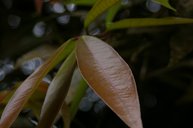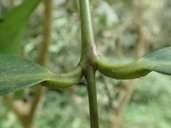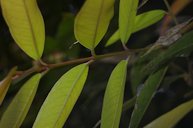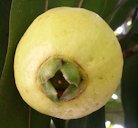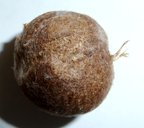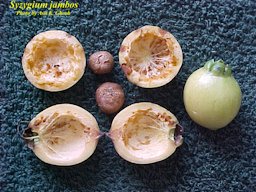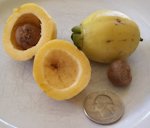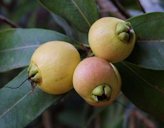| Rose Apple - Syzygium jambos | |||||||||||||||||||||||||||
|---|---|---|---|---|---|---|---|---|---|---|---|---|---|---|---|---|---|---|---|---|---|---|---|---|---|---|---|
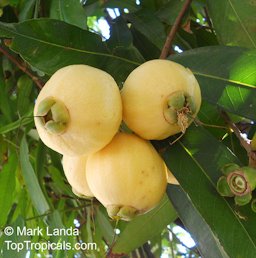 Fig. 1  Syzygium jambos, rose apple 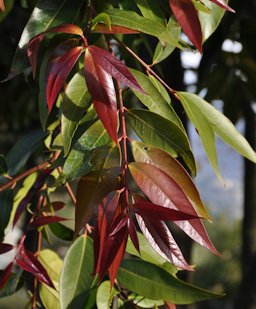 Fig. 2  S. jambos new growth  Fig. 3 Terminal leaves are always in pairs 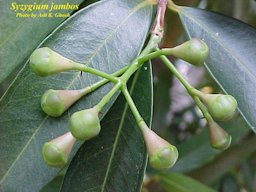 Fig. 10  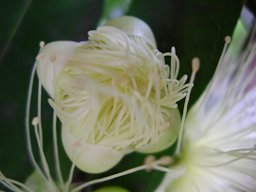 Fig. 11  S. jambos (rose apple), flowers, Hana Hwy, Maui, Hawai'i 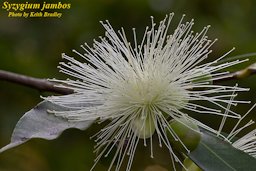 Fig. 12   Fig. 13  S. jambos, Myrtaceae Fig. 14  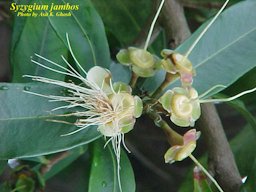 Fig. 15  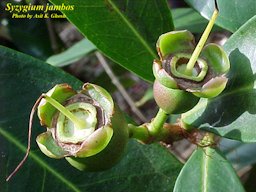 Fig. 17  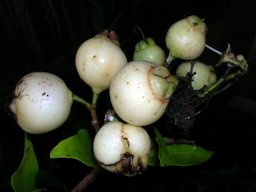 Fig. 18   Fig. 19  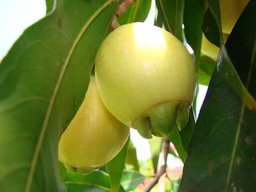 Fig. 20  Pomarrosa, S. jambos, La Pomarrosa Farm, Barlovento, north centre Venezuela 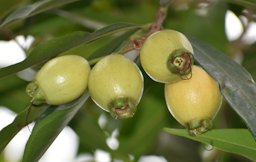 Fig. 21  Rose-apple S. jambos, Puebla, Mexico  Fig. 22  S.jambos fruit (rose apples) and foliage growing at the Marjorie McNeely Conservatory in Como Park, St. Paul, Minnesota, US 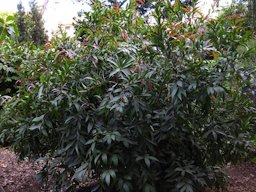 Fig. 29  Rose apple tree, Mildred E. Mathias Botanical Garden at UCLA (Los Angeles, California) 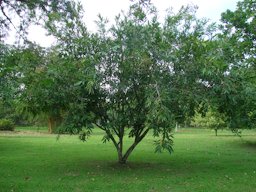 Fig. 30  Pomarrosa, S. jambos, La Pomarrosa Farm, Barlovento, north centre Venezuela  Fig. 31  Rose apple habit Mexico  Fig. 32  S. jambos, Hongkong 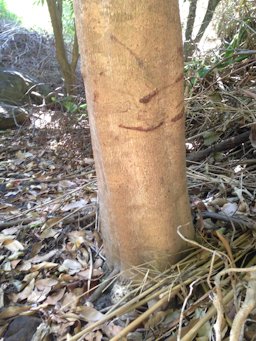 Fig. 33  S. jambos, Cape Town, South Africa 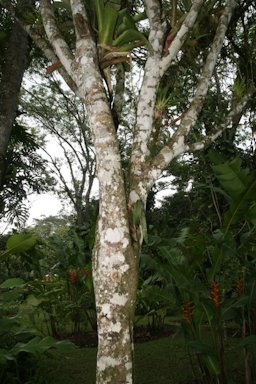 Fig. 34  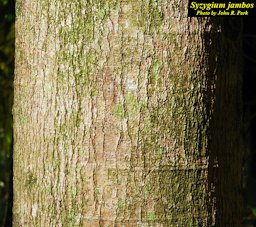 Fig. 35 |
Scientific
name Syzygium jambos (L.) Alston Pronunciation sizz-ZYE-gee-um jam-BOS 4 Common names Burmese: thabyu thabye; Chinese: pu tao; English: malabar plum, plum rose, rose apple, water apple; French: jambosier, pomme rose; German: Jambubaum, Rosenapfel, Rosenapfelbaum; Indian: jaman; Japanese: futo momo; Khmer: ch ‘puu; Laotian: chieng, kieng; Malay: jambu air mawar (Indonesia), jambu ayer mawar, jambu kelampok, jambu kelampol, jambu kraton (Indonesia), jambu mawar (Indonesia), jambu mawer; malayalam: yamu panawa; Nepalese: gulaav jaamun; Philippino: yambo; Portuguese: jambo amarelo, jambo branco, jambo rosa, jambeiro; Russian: sitsigiui dzhamboza; Spanish: jambo amarillo, manzana rosa, manzanita rosa, pomar rosa (Puerto Rico), pomarrosa manzana rosa (Cuba), pomarrosa pomo (Dominica Rep.), yambo (Philippines); Tagalog: tampoy, yambo; Thai: chomphuunaam dok mai (chomphuu namdokmai), ma nom hom (northern Thailand); Vietnamese: bodao, ly, roi 12 Synonyms Eugenia decora Salisb., E. jamboides Wender., E. jambos L, E. jambos var. sylvatica Gagnep., E. jambosa Crantz, E. malaccensis Blanco, E. malaccensis f. cericarpa (O.Deg.) H.St.John, E. monantha Merr., E. vulgaris Baill., Jambosa jambos (L.) Millsp., J. malaccensis f. cericarpa O.Deg., J. palembanica Blume, J. vulgaris DC., Myrtus jambos (L.) Kunth, Plinia jambos (L.) M.Gómez, Syzygium jambos var. jambos, S. jambos var. linearilimbum H.T.Chang & R.H.Miao, S. jambos var. sylvaticum (Gagnep.) Merr. & L.M.Perry, S. merrillii Masam., S. monanthum (Merr.) Merr. & L.M.Perry 1 Relatives Water apple (S. aqueum), Blue lilly pilly (S. coolminianum), water berry (S. cordatum), jambolan, java plum (S. cumini), water pear (S. guineense), malay apple (S. malaccense), java apple (S. samarangense) 6 Family Myrtaceae (myrtle family) Origin Southeast Asia USDA hardiness zones 9-11 5 Uses Fruit; living fence; ornamental Height 25 or even 40 ft (7.5-12 m) 3 Spread Often the overall width exceeding the height 3 Crown Dense crown of slender, wide-spreading branches 3 Plant habit Branching low on the trunk Growth rate Young plants have a slow rate of growth, speeding up as they grow older Trunk/bark/branches Twisted at the base; brown, furrowed, smooth bark 11 Leaves Evergreen; opposite; lanceolate of narrow-elliptic; glossy dark green when mature 3 Flowers Large; white to greenish-white; perfect 2,5 Fruit Drupe; globose to ovoid, smooth skin; fragrant; seeds 1-2 (-4), brown, rough coated, polyembryonic 2 Season May through July 3 Light requirement Full shade to full sun 5 Soil tolerances Copes with poor drainage; flooding; grows on various soil types 2 pH preference 5.5- 7.0, tolerating 5-8 2,7 Drought tolerance Mature tree resists short periods Aerosol salt tolerance High 5 Wind tolerance High; used as a windbreak on coffee/cocoa plantations Cold tolerance Withstands minimum temperatures down to 32 °F (0°C) 2 Roots Develops massive root systems Invasive potential * Central, South: Caution North: not a problem species Pest resistance Few Insects, but some diseases attack the tree 3 Known hazard Seeds, leaves, stems, roots and bark are poisonous due to the presence of the alkaloid jambosine and hydrocyanic acid 2 Reading Material Syzygium jambos, PROSEA Foundation Rose Apple, Fruits of Warm Climates Syzygium jambos, Agroforestree Database Rose Apple, California Rare Fruit Growers Origin Native to Southeast Asia. Planted in most tropical countries and naturalized in many parts of tropical Asia. The tree was introduced around 1762 into Jamaica, from where it spread throughout the Caribbean and Central America. It is considered invasive in some regions, including Hawaii and parts of Central America and the Galápagos Islands. 10 The rose apple was introduced into Florida, at Jacksonville, before 1877, but, as a fruit tree, it is suited only to the central and southern parts of the state. In California, it is planted as far north as San Francisco for its ornamental foliage and flowers. Because the tree occupies considerable space and the fruit is little valued, the rose apple has not been planted in Florida in recent years, though there are quite a number of specimens remaining from former times. 3 It is not a crop for commercial orchards, but the trees are widely grown in home gardens. 2 Description There are over 500 species in the genus, and S. jambos may be confused with several of them, notably another weedy species, S. cumini. However, the rosewater smell of S. jambos fruit is distinctive for the species. 8 The rose apple is a highly decorative evergreen large shrub or small tree growing to about 20 feet with low spreading branches and pale-brown bark. It is wide spreading and often will be wider than its height. 6 Leaves The leaves are about 10 x 0.6-2.4 in. (26 × 1.5-6 cm) in size, shiny and pink when young then fading to pale green on the upper side and lighter green and obscurely glandular punctate on the lower side. They are narrow and gradually tapered to the base with 0.3-0.5 in. (6-13 mm) long petiole. 11
Fig. 4. New growth Fig. 5. Rose apple, new growth, Parque Nacional Galápagos, Ecuador Fig. 6,7. Rose apple leaves, Taiwan Pollination Pollination is by bees and other insects that are strongly attracted to the plentiful nectar. 13 Flowers The flowers are creamy-white or greenish-white, 2 to 4 in (5-10 cm) wide, consisting mostly of about 300 conspicuous stamens to 1 1/2 in (4 cm) long, a 4-lobed calyx, and 4 greenish-white, concave petals. There are usually 4 or 5 flowers together in terminal clusters. 3 The flowers are a rich source of nectar for honeybees. 6
Fruit The fruit ripens 3 months after bloom. The rosewater smell of the fruit is distinctive for the species. 2 Capped with the prominent, green, tough calyx, the fruit is nearly round, oval, or slightly pear-shaped, 1 1/2 to 2 in (4-5 cm) long, with smooth, thin, pale-yellow or whitish skin, sometimes pink-blushed, covering a crisp, mealy, dry to juicy layer of yellowish flesh, sweet and resembling the scent of a rose in flavor. In the hollow center, there are 1 to 4 brown, rough-coated, medium-hard, more or less rounded seeds, 3/8 to 5/8 in (1-1.6 cm) thick, which loosen from the inner wall and rattle when the fruit is shaken. Fragments of the seedcoat may be found in the cavity. The fruit is non-climacteric. 3
Fig. 25. Seed of a rose apple that fits loosely in the central cavity of the fruit, Pretoria, South Africa Varieties There are no standard cultivars available but selections can be made from the available variability. 9 Harvesting Rose apples bruise easily and are highly perishable. They must be freshly picked to be crisp. 3 Propagation Roseapple is normally propagated by seed. The seeds have no dormancy and germinate well. A single seed often gives rise to 3-8 seedlings, most of which are true to type. Other methods of propagation include air layering, budding and grafting. Air layering is commonly done in India and Bangladesh during the quiescent season. The layers are planted after half a year. Roseapple can be budded on 10-12-month-old rootstocks using the modified Forkert method; Syzygium pycnanthum Merr. & Perry and Syzygium samarangense (Blume) Merr. & Perry can also serve as rootstocks. The juvenile phase lasts 4-5 years; air layered trees bear fruit within 4 years. 2 Planting The rose apple is too large to make a suitable container plant. 6 Adequate shade must be provided to the plants during the early stages of growth to avoid drying out by the sun. 9 Pruning Pruning of rose apples is not usually necessary. In some countries it is pruned drastically to promote dense growth and used as hedgerows around coffee plantations. 6 Irrigation The tree will tolerate semi-arid conditions, but prolonged dry spells are detrimental. It should have frequent irrigation when the weather is warm, and kept on the dry side when it’s cold. 6 Pests The rose apple tree has few insect enemies. In humid climates, the leaves are often coated with sooty mold growing on the honeydew excreted by aphids. 3 Diseases They are also prone to leaf spot caused by Cercospora sp., Gloeosporium sp., and Phyllosticta eugeniae; algal leaf spot (Cephaleuros virescens); black leaf spot (Asterinella puiggarii); and anthracnose (Glomerella cingulata). Root rot caused by Fusarium sp., and mushroom root rot (Armillariella (Clitocybe) tabescens) attack the tree. 3 Food Uses The pulp has a high pectin content, making it suitable for use as a settling agent. 2 Around the tropical world, rose apples are mostly eaten out-of-hand by children. They are seldom marketed. In the home, they are sometimes stewed with some sugar and served as dessert. Culinary experimenters have devised other modes of using the cuplike halved fruits. One stuffs them with a rice-and-meat mixture, covers them with a tomato sauce seasoned with minced garlic, and bakes them for about 20 minutes. Possible variations are limitless. The fruit is made into jam or jelly with lemon juice added, or more frequently preserved in combination with other fruits of more pronounced flavor. It is also made into a sirup for use as a sauce or to flavor cold drinks. In Jamaica, the halved or sliced fruits are candied by stewing them in very heavy sugar sirup with cinnamon. 3 When cooked with custards or puddings, they impart a rose flavor. The flowers can also be candied. 6 Nutritional Value The fruit contains per 100 g edible portion: water 84-89 g, protein 0.5-0.8 g, fat 0.2-0.3 g, carbohydrates 9.7-14.2 g, fibre 1-2 g, ash 0.3-0.4 g, carotene 123-235 IU, vitamin B complex 0.55-1.04 mg and vitamin C 3-37 mg. The energy value is 234 kJ/100 g. 2 Medicinal Properties ** In India, the fruit is regarded as a tonic for the brain and liver. An infusion of the fruit acts as a diuretic. A sweetened preparation of the flowers is believed to reduce fever. The seeds are employed against diarrhea, dysentery and catarrh. In Nicaragua, it has been claimed that an infusion of roasted, powdered seeds is beneficial to diabetics. They say in Colombia that the seeds have an anesthetic property. The leaf decoction is applied to sore eyes, also serves as a diuretic and expectorant and treatment for rheumatism. The juice of macerated leaves is taken as a febrifuge. Powdered leaves have been rubbed on the bodies of smallpox patients for the cooling effect. 3 The bark contains 7-12.4% tannin. It is emetic and cathartic. The decoction is administered to relieve asthma, bronchitis and hoarseness. Cuban people believe that the root is an effective remedy for epilepsy. 3 Other Uses In 1849, it was announced in Bengal that the ripe fruits, with seeds removed, could be distilled 4 times to make a "rosewater" equal to the best obtained from rose petals. 3 A yellow essential oil, distilled from the leaves, contains, among other properties, 26.84% dl-a-pinene and 23.84% l-limonene, and can be resorted to as a source of these elements for use in the perfume industry. 3 The wood has been used to make furniture, spokes for wheels, arms for easy chairs, knees for all kinds of boats, beams for construction, frames for musical instruments (violins, guitars, etc.), and packing cases. It is also popular for general turnery. 3 The flowers are a rich source of nectar for honeybees and the honey is a good amber color. Much comes from the San Cristobal River Valley in Cuba. 3 The bark contains 7% tannin on a dry weight basis and is used for tanning and dyeing purposes. The plant is a useful melliferous and ornamental species; with its regular shape, attractive foliage and striking appearance in bloom, it is a useful avenue tree along driveways, etc. 2 General As is often the case the botanical name is Greek tainted by Latin. Syzygium is said to refer to the tree’s paired leaves, one also sees “twin” leaves. The base word, however, is zygos (zi-GHOS) the yoke. A person’s spouse in Greece is called my Zizigos (ZEE-zee-ghos) my yoke mate. So the Greek speaker would be strongly tempted to pronounce Syzygium as zee-ZEE-ee-yum. Anglicized Latin would have it sizz-ZYE-gee-um. Jambos (jam-BOS) is the Malaysian name for rose-apple though it comes from Sanskrit’s Jambudvīpa, which means rose apple land. 4  Fig. 36. S. jambos distribution map Other Edible Syzygium Genus: Java Plum, S. cumini Malay Apple, S. malaccense Wax Jambu, S. samarangense List of Growers and Vendors |
||||||||||||||||||||||||||
| Bibliography 1 "Syzygium jambos (L.) Alston synonyms." World Flora Online, 2021, WFO, (CC0 1.0), www.worldfloraonline.org/taxon/wfo-0000318809. Accessed 27 June 2021. 2 van Lingen, T. G. "Syzygium jambos (L.) Alston." Edible fruits and nuts, Plant Resources of South-East Asia No 2, Edited by Verheij, E. W. M. and Coronel, R. E., PROSEA Foundation, Bogor, Indonesia, record 1530,1991, PROSEA, (CC BY-NC-SA 3.0), www.prota4u.org/prosea/view.aspx?id=1549. Accessed 26 June 2021. 3 Fruits of Warm Climates. Julia F. Morton. Miami, 1987. 4 Deane, Green. "Syzygium: A Jumble of Jambul." Eat the Weeds and other things, too. www.eattheweeds.com/syzygium-a-jumble-of-jambul-2/. Accessed 10 June 2018. 5 "Syzygium jambos Tree Record." SelecTree, Cal Poly State University, San Luis Obispo, 1995-2021, UFEI., selectree.calpoly.edu/tree-detail/1369. Accessed 27 June 2021. 6 "Syzygium jambos." California Rare Fruit Growers, crfg.org/wiki/fruit/rose-apple/. Accessed 29 June 2021. 7 "Syzygium jambos." Plants For A Future, via Ecocrop, PFAF, pfaf.org/user/Plant.aspx?LatinName=Syzygium+jambos. Accessed 29 June 2021. 8 "Syzygium jambos (rose apple) dataset." Invasive Species Compendium, Wallingford, UK: CAB International, 20 Nov. 2019, CABI, www.cabi.org/isc/datasheet/52443. Accessed 29 June 2021. 9 Pareek, Om Prakash, and Suneel Sharma. "Rose Apple." Underutilized Fruits and Nuts Vol.2: Fruits of tropical region, EPDF, epdf.pub/underutilized-fruits-and-nuts-vol2-fruits-of-tropical-region.html. Accessed 30 June 2021. 10 Blancke, Rolf. "Tropical Fruits and Other Edible Plants of the World: An Illustrated Guide." Zlibrary, 2016, b-ok.cc/book/3414166/f1bf9d?dsource=recommend. Accessed 30 June 2021. 11 Subhadrabandhu, Suranant. "Chomphu-nam dok mai (Syzygium jambos (L.) Alston)." Under-utilized Tropical Fruits of Thailand, Rap pub.: 2001/26, Food And Agriculture Organization of the United Nations, Dec. 2001, FAO, www.fao.org/3/ab777e/ab777e00.htm. Accessed 30 June 2021. 12 The Encyclopedia of Fruit & Nuts. Edited by Jules Janick and Robert E. Paull, Cambridge, CABI, 2008. 13 "Rose Apple, also called Malabar Plum, Syzygium jambos." The Rare Fruit Club WA, www.rarefruitclub.org.au/RoseApple.htm. Accessed 30 June 2021. Photographs Fig. 1 Landa, Mark. " Syzygium jambos, Eugenia jambos, Jambosa jambos." Top Tropicals, toptropicals.com/cgi-bin/garden_catalog/cat.cgi?find=Syzygium jambos. Accessed 29 June 2021. Fig. 2 Reimer, J., and C. Stubler. "Syzygium jambos leaves." SelecTree, Cal Poly State University, San Luis Obispo, 1995-2021, UFEI., selectree.calpoly.edu/tree-detail/1369. Accessed 27 June 2021. Fig. 3 Hoyer, Rich. "Rose-Apple Syzygium jambos. Guyana." iNaturalist Research Grade, no. 18869460, 6 Dec. 2018, (CC BY-NC 4.0), www.inaturalist.org/observations/18869460. Accessed 29 June 2021. Fig. 4,23 Koffermejia. "Pomarrosa." Wikimedia Commons, 19 May 2019, (CC-BY-SA 4.0), Image cropped, commons.wikimedia.org/wiki/Category:Syzygium_jambos_(fruit)#/media/File:Pomarrosa_01.jpg. Accessed 29 June 2021. Fig. 5,9 Johnston, Don. "Rose Apple, Syzygium jambos. Parque Nacional Galápagos, Ecuador." iNaturalist Research Grade, no. 69024586, 3 Feb. 2021, Public Domain, www.inaturalist.org/observations/69024586. Accessed 29 June 2021. Fig. 6,7 weicheng. "Rose-Apple Syzygium jambos. Taiwan." iNaturalist Research Grade, no. 44098464, 16 Apr. 2020, (CC BY-NC 4.0), www.inaturalist.org/observations/44098464. Accessed 29 June 2021. Fig.8 Lin, Yi-Han. "Rose-Apple Syzygium jambos. Taiwan." iNaturalist Research Grade, no. 22648291, 18 Apr. 2019, (CC BY-NC 4.0), www.inaturalist.org/observations/22648291. Accessed 29 June 2021. Fig. 10,15,17,19,26 Ghosh, Asit K. "Syzygium jambos." Herbarium Slide Collection, Institute for Systematic Botany, University of South Florida, Tampa, S. M. Landry and K. N. Campbell (application development), USF Water Institute, 2020, Atlas of Florida Plants, florida.plantatlas.usf.edu/photo.aspx?ID=3113. Accessed 26 June 2021. Fig. 11 Starr, Forest, and Kim. "Syzygium jambos (Rose apple), Flowers. Hana Hwy, Maui, Hawai'i." Starr Environmental, no. 050107-2981, 7 Jan. 2005, (CC BY 4.0), www.starrenvironmental.com/images/image/?q=24734308735. Accessed 29 June 2021. Fig. 12 Bradley, Keith. "Syzygium jambos." Herbarium Slide Collection, Institute for Systematic Botany, University of South Florida, Tampa, S. M. Landry and K. N. Campbell (application development), USF Water Institute, 2020, Atlas of Florida Plants, florida.plantatlas.usf.edu/photo.aspx?ID=3113. Accessed 26 June 2021. Fig. 13 Carr, G. D. "Syzygium jambos, Myrtaceae. Near mauka end of Japanese garden behind Jefferson Hall." University of Hawai'i, Botany Dept., Mānoa Campus Plants, 29 Mar. 2006, www.botany.hawaii.edu/faculty/carr/images/syz_jam_3209.jpg. accessed 26 June 2021. Fig. 14 B.Navez. "Syzygium jambos (flower)." Wikipedia, 19 May 2006, (CC-BY-SA), GFDL, en.wikipedia.org/wiki/Syzygium_jambos#/media/File:Syzygium_jambos.JPG. Accessed 29 June 2021. Fig. 16 Aguilar, Reinaldo. "Syzygium jambos (L.) Alston, Manzana rosa." Vascular Plants of the Osa Peninsula, Costa Rica, 22 Dec. 2015, Flickr, (CC BY-NC-SA 2.0), www.flickr.com/search/?user_id=56339362%40N03&view_all=1&text=Syzygium jambos. Accessed 30 June 2021. Fig. 18 Rakotoarivony, Fortunat. "Syzygium jambos (L.) Alston." World Flora Online, 2021, WFO, (CC BY-NC-ND 3.0), www.worldfloraonline.org/taxon/wfo-0000318809. Accessed 27 June 2021. Fig. 20,30 barloventomagico. "Pomarrosa [Pommerose, Malay apple, Malabar plum] (Syzygium jambos). La Pomarrosa Farm, Barlovento, north centre Venezuela." Flickr, 27 Apr. 2008, (CC BY-NC-SA 2.0), www.flickr.com/photos/barloventomagico/2452373151. Accessed 30 June 2021. Fig. 21 Larroyo. "Rose-Apple Syzygium jambos. Puebla, Mexico." iNaturalist Research Grade, no. 42361648, 16 Apr. 2020, (CC BY-NC 4.0), www.inaturalist.org/observations/42361648. Accessed 29 June 2021. Fig. 22 Jonathunder. "Syzygium jambos fruit (rose apples) and foliage growing at the Marjorie McNeely Conservatory in Como Park, St. Paul, Minnesota, US." Wikipedia, 11 Sept. 2019, GFDL, en.wikipedia.org/wiki/Syzygium_jambos#/media/File:RoseApples.jpg. Accessed 29 June 2021. Fig. 24 User:MKwek. "A matured fruit of Syzygium jambos, which is called jambu mawar in Malay language. Location: Cheras, Kuala Lumpur, Malaysia." Wikimedia Commons, 9 Dec. 2012, (CC-BY-SA 3.0), , Image cropped, commons.wikimedia.org/wiki/File:Syzygium_jambos_(Jambu_mawar).jpeg. Accessed 29 June 2021. Fig. 25 JMK. "Seed of a Rose apple that fits loosely in the central cavity of the fruit. From a plant at the Manie van der Schijff Botanical Garden, Pretoria, South Africa." Wikimedia Commons, 26 Jan. 2013, (CC-BY-SA 3.0), commons.wikimedia.org/wiki/File:Syzygium_jambos_(Jambu_mawar).jpeg. Accessed 29 June 2021. Fig. 27 I likE plants! l"Rose Apple, Syzygium jambos." Flickr, 5 May 2009, (CC BY 2.0), www.flickr.com/photos/i_like_plants/3515003107/in/photolist-667SaU-6mBiXR-6mBiUT-663BKR. Accessed 30 June 2021. Fig. 28 Mercadante, Mauricio. "Syzygium jambos (L.) Alston." Flickr, 29 Nov. 2012, (CC BY-NC-SA 2.0), www.flickr.com/photos/mercadanteweb/8231533410/in/photolist/. Accessed 29 June 2021. Fig. 29 Kojian, Raffi. "Rose Apple tree, Mildred E. Mathias Botanical Garden at UCLA (Los Angeles, California)." Wikimedia Commons, via Gardenology, 9 Nov. 2009, (CC-BY-SA 3.0), commons.wikimedia.org/wiki/File:Gardenology.org-IMG_2547_ucla09.jpg. Accessed 29 June 2021. Fig. 31 Mora, Louis. "Rose-Apple Syzygium jambos. Mexico." iNaturalist Research Grade, no. 69698463, 16 Apr. 2020, (CC BY-NC 4.0), www.inaturalist.org/observations/69698463. Accessed 29 June 2021. Fig. 32 Dickson, Paul. "Rose-Apple Syzygium jambos. Taiwan." iNaturalist Research Grade, no. 44098464, 28 June 2020, (CC BY-NC 4.0), www.inaturalist.org/observations/44098464. Accessed 29 June 2021. Fig. 33 Brown, Penelope. "Rose-Apple Syzygium jambos. Cape Town, South Africa." iNaturalist Research Grade, no. 69496708, 18 Apr. 2019, (CC BY-NC 4.0), www.inaturalist.org/observations/69496708. Accessed 29 June 2021. Fig. 34 Stang, David. "Syzygium jambos (L.) Alston." World Flora Online, 2021, WFO, (CC BY-NC-ND 3.0), www.worldfloraonline.org/taxon/wfo-0000318809. Accessed 27 June 2021. Fig. 35 Park, John R. "Syzygium jambos." Herbarium Slide Collection, Institute for Systematic Botany, University of South Florida, Tampa, S. M. Landry and K. N. Campbell (application development), USF Water Institute, 2020, Atlas of Florida Plants, florida.plantatlas.usf.edu/photo.aspx?ID=3113. Accessed 26 June 2021. Fig. 36 Wunderlin, R. P., et al. "Syzygium jambos distribution map." Institute for Systematic Botany, University of South Florida, Tampa, S. M. Landry and K. N. Campbell (application development), USF Water Institute, 2020, Atlas of Florida Plants, florida.plantatlas.usf.edu/Plant.aspx?id=4403. Accessed 26 June 2021. * UF/IFAS Assessment of Non-native Plants in Florida's Natural Areas ** Information provided is not intended to be used as a guide for treatment of medical conditions. Published 2 July 2021 LR |
|||||||||||||||||||||||||||

